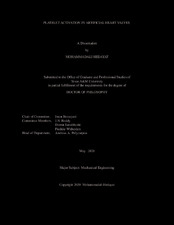| dc.description.abstract | A numerical framework is developed to perform multi-scale (hinge-to valve-scale) flow simulation and quantify the thrombogenic performance of prosthetic heart valves. This aim is achieved by 1) developing a parallel dynamic overset grid and combining it with the curvilinear immersed boundary (overset-CURVIB) method to reduce the computational cost; and 2) developing a framework for evaluating the thrombogenic performance of heart valves in terms of platelet activation. The dynamic overset grids are used to locally increase the grid resolution near immersed bodies, which are handled using a sharp interface immersed boundary method, undergoing large movements as well as arbitrary relative motions. The new framework extends the previous overset-CURVIB method with fixed overset grids and a sequential grid assembly to moving overset grids with an efficient parallel grid assembly. In addition, a new method for the interpolation of variables at the grid boundaries is developed which can drastically decrease the execution time and increase the parallel efficiency. This overset grid framework is integrated with a framework to quantify the platelet activation which is developed using a Eulerian frame of reference which calculates the activation over the whole computational domain (contrary to Largrangian methods which use limited number of particles). The new framework is verified and validated against experimental data, and analytical/benchmark solutions. This framework is used to compare the role of systole phase in the poor performance of bileaflet mechanical heart (BMHV) valve by using the bioprothtetic heart valve as a control. The results show that the activation in the bulk flow during the systole phase might play an essential role in poor hemodynamic performance of BMHVs. In addition, the contribution of bulk and hinge flows to the activation of platelets in BMHVs is quantified for the first time by performing simulations of the flow through a BMHV and resolving the hinge by overset grids. The total activation by the bulk flow is found to be several folds higher than that by the hinge/leakage flow. This is mainly due to the higher flow rate of the bulk flow which exposes much more platelets to shear stress than the leakage flow. For the future work, this framework is going to be applied for thrombogenic optimization of new designs of mechanical heart valves including trileaflet ones as well as patient-specific hemodynamic analysis of heart valves using fluid-structure interaction in more realistic geometries extracted from the medical images such as echocardiography. | en |


